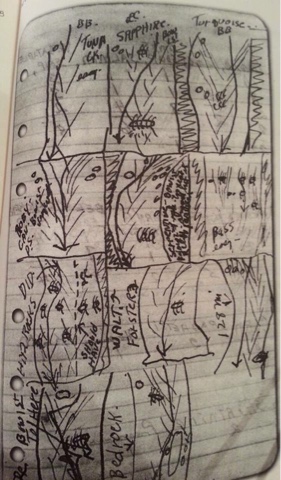As DBP MAGAZINE ONLINE Associate Editor and Chief Historian (we throw titles to each other faster than ropes; we’re Dirtbags of course) I want to encourage folks out there to write their own history. If the idea seems ‘nerdy’ or obsessive compulsive let me put you at ease. The first and perhaps only person you would do this for would be yourself. There will be no grade for your effort at the end of the season. You don’t need to aspire to become a writer, poet, humorist, competitive athlete or statistician. Do it for yourself. I believe you’ll get more out of it than you expect. There are no rules or structure you need to follow. Try it and you’ll see how even the mundane can become monumental. In the end, what you get out of it will be more than the sum of the parts. It’s your history.
I’ve been asked more than a few times how to go about writing a journal or log book.The first couple of questions are, “What should I write in it?” and “What do I write?” You can use a pocket Day-Planner, or a plain calendar with blank squares. Maybe a spiral bound type of calendar is a little more convenient for carrying around. A simple spiral bound notebook works fine, or if you want to make the investment get a nice journal made for the purpose, with blank pages if you are inspired to do that.
Personally, I have to admit that by and large, my own river logs are just that: logistical. Generally, I list the stretch of river; the water level if free flowing or if dam controlled, I might only mention the level if it’s unusual; the number of runs for the day; often something significant to help jog my memory of the day. It could be unusual weather; maybe the names and the number of people in my crew when guiding, if I want to remember them (and the tip). I might even include something I might otherwise want to forget: an injury, a flip or a pin, not necessarily my own, something that I or someone else might remember about that day. There have been a number of times this information has been useful for me.
In the past I’ve run across people that keep a sort of guest register. For them it was used in a variety of ways. One used his as a way of staying in touch with his guests and later, to piece together a travel itinerary for cross country travel, thereby avoiding lodging costs and usually meals during his stay, plus the added bonus of good company of his choosing. Another, an iconic West Virginia guide and revered river associate of mine, found that he often had conflicting guide requests. He was able to cross reference his information to determine which he should honor. Quite clever on both counts in economic terms. It’s also an excellent way to ensure a good time with pleasurable people. No one could find fault in that.
There are those who keep a book of prose, poetry or short stories and find no compulsion to make entries on a daily basis, but rather when the mood strikes them. There are those who keep a daily diary making an entry each day, long or short depending on the events of the day. Others keep a document of more technical information: shopping lists; needed repairs; mileage; side hikes; campsites and the like. Even though this information might not seem important in the long-term, it can provide a framework to support memories.
The most amazing river chronicler I’ve run across is Buzz Holmstrom. Of his many accomplishments, he is best known for soloing the Grand Canyon. He soloed the Rogue and the Salmon rivers as well and traversed the North American Continent, retracing the return route of Lewis and Clark’s exploratory trip. Throughout his adventures he kept small 3″x5″ spiral bound notebooks. The type of entries he made encompass nearly every approach listed above. These notebooks were used to piece together pivotal information in a book about his life, “The Doing of the Thing”, by: Welch, Conley and Dimock. Brad Dimock went on to edit Holmstrom’s journals for another book, “Every Rapid Speaks Plainly.” Both titles are taken from a single entry near the end of his solo Colorado trip. The information needed to be decoded, as he had used a combination of short-hand, abbreviation and purposeful misspelling to conserve time and space in his little books. Both of the contemporary books on Holstrom are a must read for any river runner and fascinating for adventurers of all types.
Just recently a friend and fellow DBP Admin discovered that his Go-Pro was out of order. Of course that made little impact on whether or not he would go boating that day. As it turned out, he had such an awesome session that that he decided to sit down and write about it. He had but one photo to remember the day by. The picture was taken at the take out. One of his partners took a swim and was covered with a sheet of ice and a winning smile. Although they say that a picture is worth a thousand words, combining the photo with the text and posting the two together, elicited, in his words, a bigger response than any video he had ever posted.
When asked in the past about writing a journal, it’s now a little easier for you to understand why I might have seemed vague and noncommittal on the subject. I really can’t tell you how to write your own. There is no one format, no rules and no grade for quality or content. It’s all you, write like no-one is going to see it, write for yourself. It’s your history.
PHOTOS-
#1.samples of journal types I’ve used
#2.page from Buzz’s Colorado journal
#3.Buzz’s rapid drawings
#4.transcript of shopping list by Holmstrom




